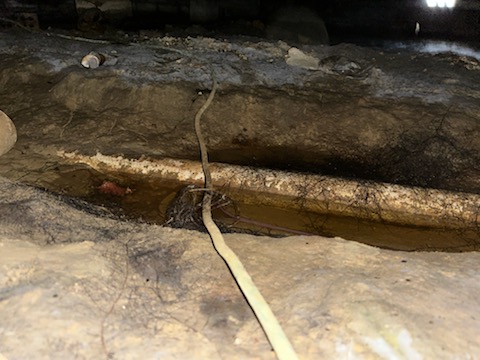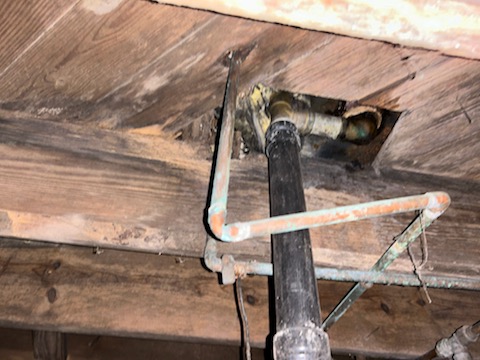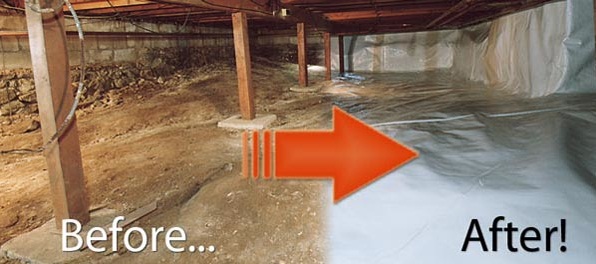Identifying and Addressing Water Mold in Your Crawl Space
Did you find mold in your crawl space? This can be alarming for any homeowner. Crawl spaces are damp, dark, and have poor ventilation—all ideal conditions for mold growth. While there are many types and colors of mold, a common type found in crawl spaces occurs over water. This is called water mold. Let’s take a dive into this “moldy water” to confirm how it appears, what it looks like, and how you can address the issue.

What Does Water Mold Look Like?
Water mold is actually not mold; it’s a cluster of microorganisms called Oomycetes that live on top of the water. True molds have a fuzzy or threadlike appearance; water mold often appears as a slimy or cottony growth. Colors may be white or gray, brown, or even black. In its early stages, water mold resembles a cobweb or a thin film, but as it matures, it forms a more cotton-like or fluffy texture.
How Does Water Mold Get into Your Crawl Space?
As you may have guessed, water mold thrives in wet environments, so it’s no surprise that crawl spaces with standing water are particularly susceptible. How does standing water form in your crawl spaces? Here are a few ways it can happen:
- Leaky pipes or appliances: Do you have plumbing or an HVAC unit? A dishwasher or washing machine? These can introduce a steady supply of water into your crawl space.
- Groundwater seepage: The fact is that Central Virginia has a wet and humid climate. Water will seep into your home’s foundation if it isn’t properly sealed, especially after heavy rain.
- Poor drainage: Did you know that your home’s foundation and the ground under your home (in your crawl spaces) are supposed to allow water to flow away from your home? If the grading was done improperly or has eroded due to water or pests over time, you’ll eventually see water seeping into your crawlspace.
- Condensation: During humid weather, condensation can form on cool surfaces in the crawl space, providing enough moisture for water mold to grow. Lack of overall moisture control will ultimately lead to more moisture in your crawl space.

What to Do About Water Mold in Your Crawl Space
Have you seen water mold in your crawl space? NOW is the time to act in order to prevent further damage and even preserve your health and your family’s health. Here are some steps you can take:
- Identify and fix the source of moisture: The first step is to cut off the source of the issue. Fix leaky pipes, replace appliances, improve the drainage around your home, and seal foundation cracks.
- Remove standing water: This can be done with a sump pump or a wet/dry vacuum to remove any standing water in the crawl space.
- Dry out the crawl space: It is also critical to increase ventilation in the crawl space. Open vents, use fans, and use a dehumidifier to help remove excess moisture from the air.
- Clean and disinfect affected areas: Use a stiff brush and a solution of bleach and water to scrub away water mold from affected surfaces. Be sure to wear protective gear, including gloves, goggles, and a respirator mask, when working with bleach. At Vance Insulation, we use a high-pressure spray and wipe down every floor joist to ensure proper cleansing of the crawl space area.
- Consider professional help: If the water mold infestation is extensive or if you’re uncomfortable handling the cleanup yourself, consider hiring a professional mold remediation company. They can also provide solutions for preventing future mold growth, through encapsulation of your crawl space.
Need help with your crawl space? If you’re in Central Virginia and dealing with water mold or other crawl space issues, Vance Insulation can help. With 60 years of experience serving tens of thousands of customers, Vance Insulation has the expertise to diagnose and repair your crawl space problems. They offer flexible payment options to make the process easier. Let Vance Insulation take a look and help you create a dry, healthy crawl space.

By taking swift action and addressing the moisture issue, you can effectively eliminate water mold from your crawl space and prevent it from returning. Regular inspections and maintenance of your crawl space can help you catch potential problems early on and keep your home healthy and safe.
